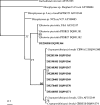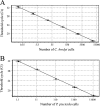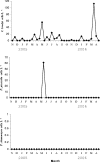Development of a real-time PCR probe for quantification of the heterotrophic dinoflagellate Cryptoperidiniopsis brodyi (Dinophyceae) in environmental samples
- PMID: 17322326
- PMCID: PMC1855596
- DOI: 10.1128/AEM.02389-06
Development of a real-time PCR probe for quantification of the heterotrophic dinoflagellate Cryptoperidiniopsis brodyi (Dinophyceae) in environmental samples
Abstract
A TaqMan format real-time PCR probe was developed against the internal transcribed spacer 2 ribosomal DNA region for the specific detection and quantification of Cryptoperidiniopsis brodyi in environmental samples. The assay specificity was confirmed by testing against related dinoflagellates and verified by sequencing PCR amplicons from natural water samples. Phylogenetic analysis of the sequenced environmental samples also showed that this assay is specific to C. brodyi. The C. brodyi-specific assay was used in conjunction with Pfiesteria piscicida- and Pfiesteria shumwayae-specific real-time PCR assays to investigate the temporal variations of C. brodyi, P. piscicida, and P. shumwayae abundance in the Derwent estuary, Tasmania. The 18-month field survey from November 2004 to April 2006 revealed that C. brodyi occurred in all seasons at very low densities, mostly below 25 cells liter(-1), with higher abundance (maximum, 112 cells liter(-1)) in April and May. P. piscicida was detected only once, in May 2005 at 60 cells liter(-1). P. shumwayae was not detected during the survey.
Figures






Similar articles
-
Development of a cob-18S rRNA gene real-time PCR assay for quantifying Pfiesteria shumwayae in the natural environment.Appl Environ Microbiol. 2005 Nov;71(11):7053-63. doi: 10.1128/AEM.71.11.7053-7063.2005. Appl Environ Microbiol. 2005. PMID: 16269741 Free PMC article.
-
Stoeckeria algicida n. gen., n. sp. (Dinophyceae) from the coastal waters off Southern Korea: morphology and small subunit ribosomal DNA gene sequence.J Eukaryot Microbiol. 2005 Jul-Aug;52(4):382-90. doi: 10.1111/j.1550-7408.2005.00051.x. J Eukaryot Microbiol. 2005. PMID: 16014017
-
Detection of the Dinozoans Pfiesteria piscicida and P. shumwayae: a review of detection methods and geographic distribution.J Eukaryot Microbiol. 2005 Mar-Apr;52(2):83-9. doi: 10.1111/j.1550-7408.2005.05202007.x. J Eukaryot Microbiol. 2005. PMID: 15817112 Review.
-
Characterization of the rRNA locus of Pfiesteria piscicida and development of standard and quantitative PCR-based detection assays targeted to the nontranscribed spacer.Appl Environ Microbiol. 2002 Nov;68(11):5394-407. doi: 10.1128/AEM.68.11.5394-5407.2002. Appl Environ Microbiol. 2002. PMID: 12406730 Free PMC article.
-
Pfiesteria piscicida, P. shumwayae, and other Pfiesteria-like dinoflagellates.Res Microbiol. 2003 Mar;154(2):85-90. doi: 10.1016/S0923-2508(03)00027-5. Res Microbiol. 2003. PMID: 12648722 Review.
Cited by
-
Molecular detection, quantification, and diversity evaluation of microalgae.Mar Biotechnol (NY). 2012 Apr;14(2):129-42. doi: 10.1007/s10126-011-9427-y. Epub 2011 Dec 28. Mar Biotechnol (NY). 2012. PMID: 22200918 Review.
-
Detection and Quantification of the Harmful Dinoflagellate Margalefidinium polykrikoides (East Asian Ribotype) in the Coastal Waters of China.Toxins (Basel). 2022 Jan 25;14(2):95. doi: 10.3390/toxins14020095. Toxins (Basel). 2022. PMID: 35202121 Free PMC article.
-
Evaluating the ribosomal internal transcribed spacer (ITS) as a candidate dinoflagellate barcode marker.PLoS One. 2012;7(8):e42780. doi: 10.1371/journal.pone.0042780. Epub 2012 Aug 16. PLoS One. 2012. PMID: 22916158 Free PMC article.
-
Evaluating detection limits of next-generation sequencing for the surveillance and monitoring of international marine pests.PLoS One. 2013 Sep 4;8(9):e73935. doi: 10.1371/journal.pone.0073935. eCollection 2013. PLoS One. 2013. PMID: 24023913 Free PMC article.
-
Molecular detection of harmful algal blooms (HABs) using locked nucleic acids and bead array technology.Limnol Oceanogr Methods. 2010 Jun 1;8:269-284. doi: 10.4319/lom.2010.8.269. Limnol Oceanogr Methods. 2010. PMID: 21165155 Free PMC article.
References
-
- Bolch, C. J. S. 2001. PCR protocol for genetic identification of dinoflagellates directly from single cysts and plankton cells. Phycologia 40:162-168.
-
- Bowers, H. A., T. M. Trice, R. E. Magien, D. M. Goshorn, B. Michael, E. F. Schaefer, P. A. Rublee, and D. W. Oldach. 2006. Detection of Pfiesteria spp. by PCR in surface sediments collected from Chesapeake Bay tributaries (Maryland). Harmful Algae 5:342-351.
-
- Burkholder, J. M., and H. B. Glasgow. 1995. Interactions of a toxic estuarine dinoflagellate with microbial predations and prey. Arch. Protistenkd. 145:177-188.
Publication types
MeSH terms
Substances
Associated data
- Actions
- Actions
- Actions
- Actions
- Actions
- Actions
- Actions
- Actions
LinkOut - more resources
Full Text Sources
Miscellaneous

